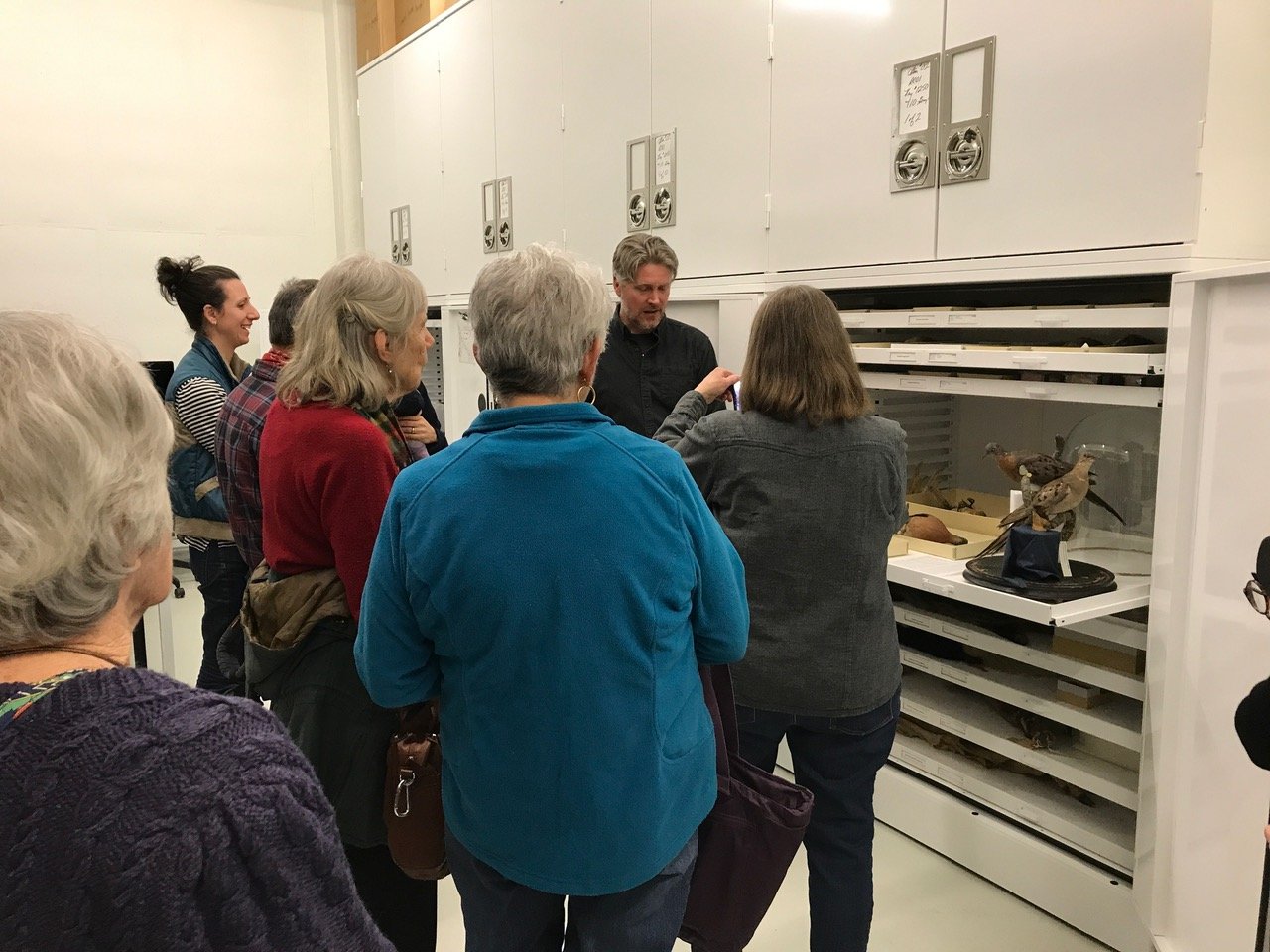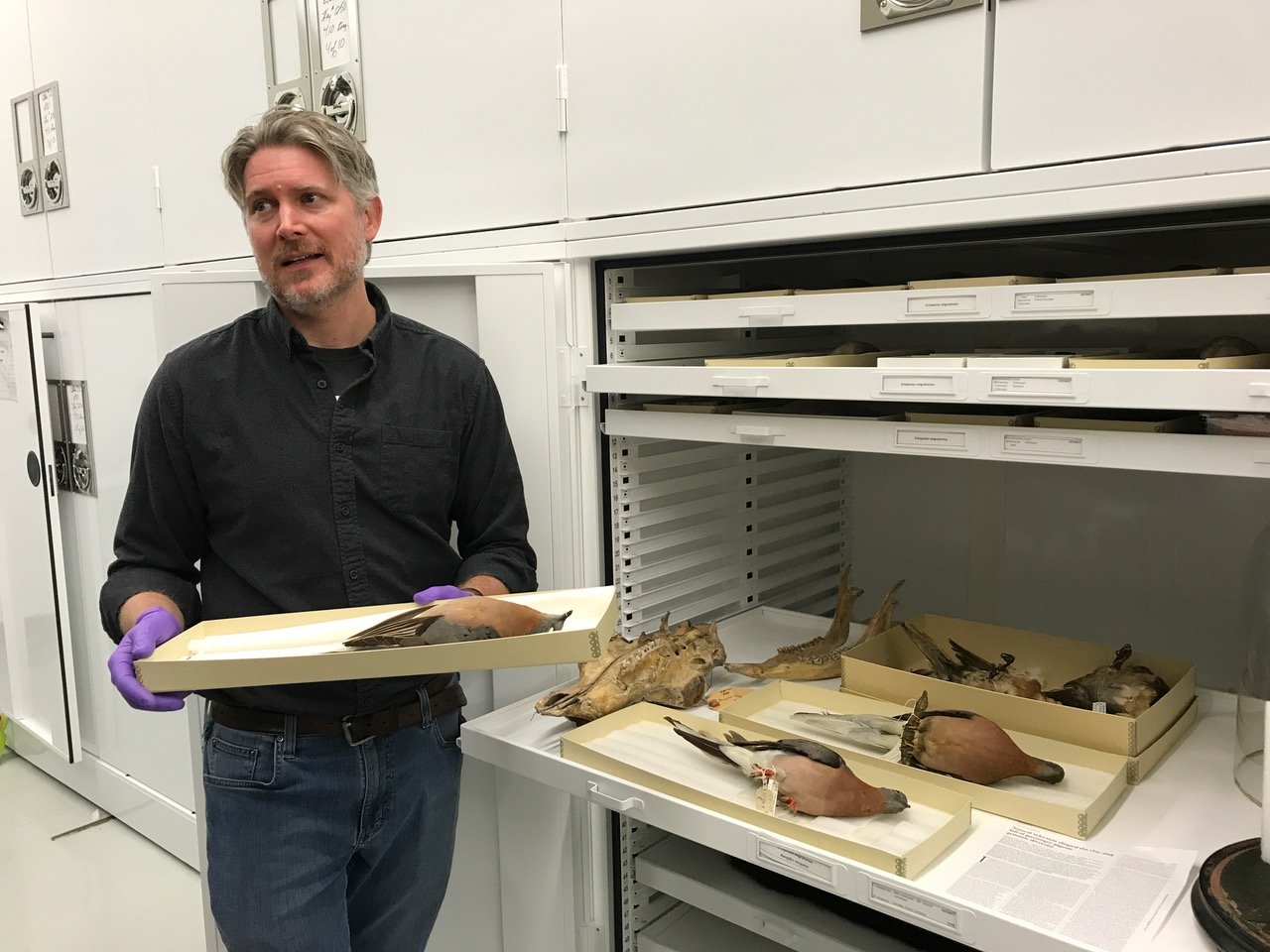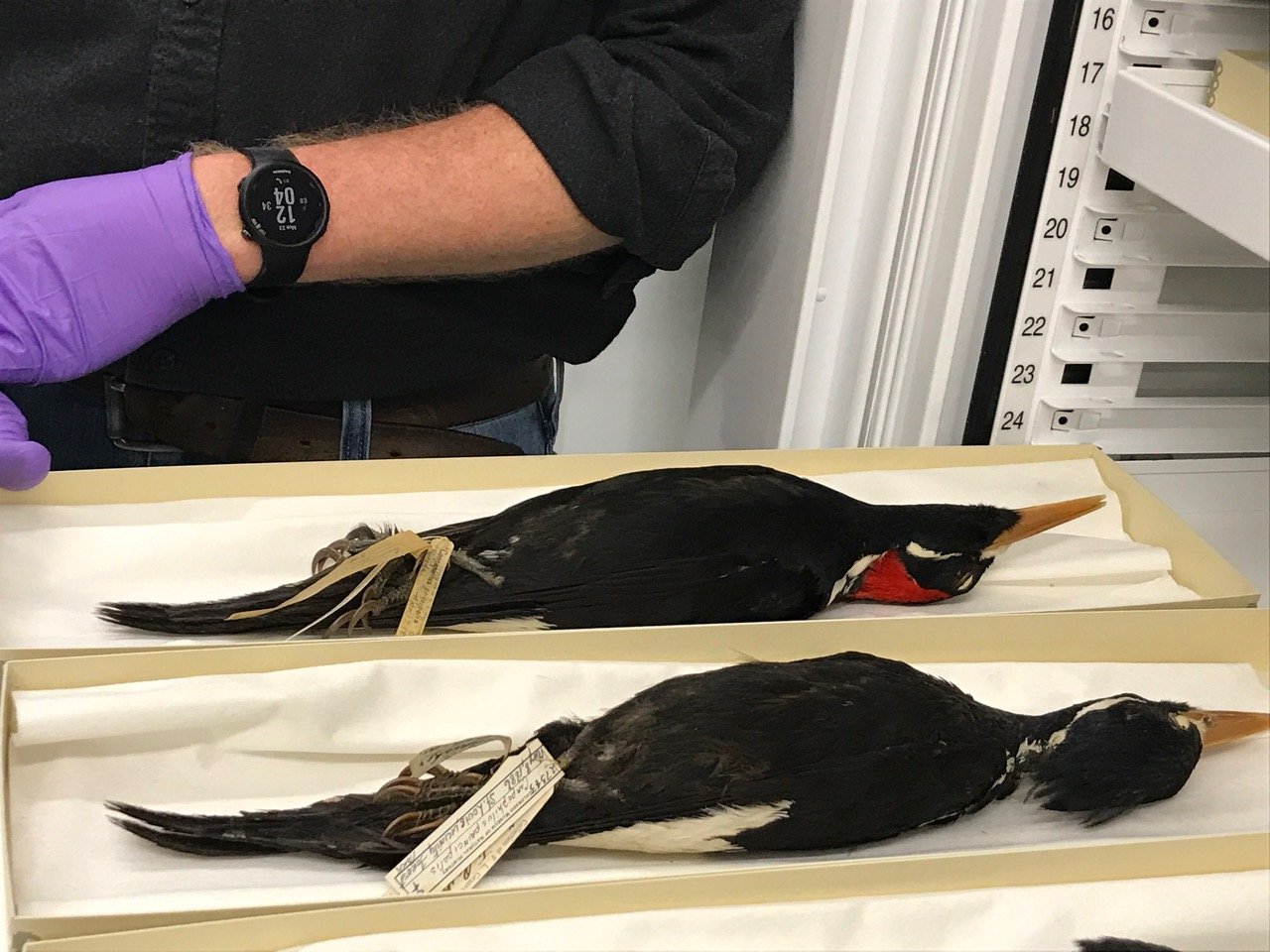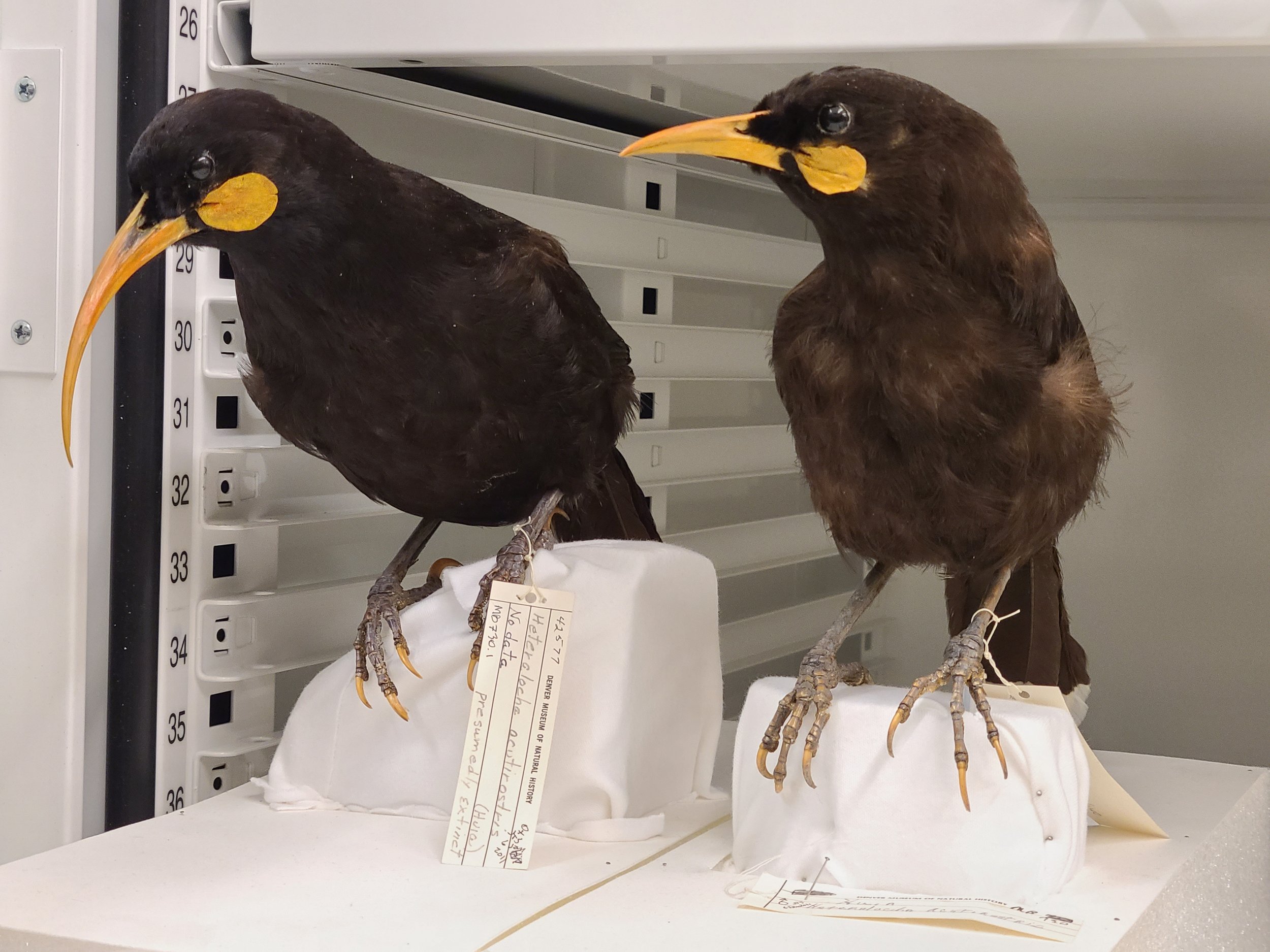A Strange and Amazing Time With Dead Creatures
By Madeline Goldhawk
There is an early morning drive to the Denver Museum of Nature And Science for Carron M., Carol K., Carol M., Jean-Pierre G., Linda A-G., Elaine H., Maureen L., Madeline G., Lynn M., Amory S. and Laura F., and sweet baby Ursula. This is a Boulder County Audubon Interludes field trip, a special fundraiser for the teen bird camp scholarships. We gather at the life-size, bone-cast model of T-rex. It looms tall and greets all. It is beloved by many children. We meet our tour leaders, Jeff Stephenson and Andrew Doll, friendly and so knowledgeable.
They lead us inside, to slip through mystery doors to mystery halls in the museum. On a giant elevator, with gates and locks, we descend 61 feet below ground level of this Mile High City. It is a journey to the land of dead animals – not for burial, but for study and display. Some animal carcasses will wait in freezers. Many dead animals are gathered and given to the museum. Some are common and too many to keep. But some are rare – like that Magnificent Frigatebird found in Colorado – such a treasure!
We enter the “prep” room, an early step in doom. Andie, a pleasant young woman, works on a beat-up carcass of a pelican. It will become a fine white bird skeleton…but now. I don’t like the smell. I am suddenly considering becoming a vegetarian. There are stories of skunk odor getting into the museum's main vent system…even closing down the IMAX theater. “Cut the skunks carefully”, says Carron…and be grateful for the room’s new vent system. We peer into the drying room, full of animal pieces, set on racks, with red meat still on the bone. It is like a larder for mountain lion leftovers…but all the meat is tag-labeled. Andrew opens a thick-sided, kiln-like, huge bin. Dark beetles crawl all over…a bony camel, all chopped up. Carrion beetles are sensible for a good cleanup of tissue. No chemicals used! Untainted bones will be best for further study. From the carcasses, vials hold insects, parasites, maggots, and “other”- all good for further study. The lovely lady of the pelican, wearing a long white smock and blue gloves, recalls an encounter with a dangerous bacteria. I ask about a shower for staff. There is an emergency shower in the room. I see washing machines… for smocks?
I note that all is labeled with species, date, provenience, and more. Every specimen we see, and all the other 10s and 100s of thousands of items in this museum are. I don’t recall the numbers tossed about; but insects, birds, mammals, and whatever else are all labeled.
We move through other doors to a room with an international menagerie of mammals, birds, insects, and seashells. This museum specializes in Rocky Mountain and Western Plains wildlife but receives much more. Specimens have come from rich collectors, big game hunters, this museum’s past expeditions afar, in buys and trades with other museums. There is now a big inter-museum database. Many items date back to the 19th and 20th centuries, and some far earlier. The Denver Zoo, down the street, supplies some dead animals. These are exhibit-ready animals. Wild cats from various continents are so beautiful. Most amazing to me is standing before a rare snow leopard, posed on artificial snow and rock. From tiny rodents to a standing bison, so much is here. Swan and Sandhill Crane skeletons stand side by side. They are nearly the same size, but the swan is slightly taller! “Birds are mostly feathers”, says Andrew. And he mentions that feathers have amazing properties. A dark, fat grackle has been reduced to a delicate, white filigree of bone.
We move on to specially built, floor to high ceiling, huge metal cabinets, parked side by side. They can be moved across a floor track like big freight trailers; moved to open or close pathways of access. On these “freight trailer” cabinets, doors open to multiple trays and cubbies of endless labeled specimens. Very interesting is the cabinet of extinct birds. There are Passenger Pigeons, Ivory-billed Woodpeckers, and a New Zealand Huia pair. Most amazing are two, intact, ancient eggshells (balloon-sized) of the long-extinct Elephant Bird of Madagascar; maybe 1000 years old. A drawing shows a perhaps 10-foot Elephant Bird towering over a 6-foot man. Non-flying, it stands on powerful bird feet. “Avian dinosaur” we murmur. Jeff had spoken of current talk of avian dinosaurs and non-avian dinosaurs. The dinosaur-bird connection is much stressed now.
So many creatures, large and small, appear in magnificent dioramas, displayed upstairs in the main halls of the museum. The best dioramas in the country, we are told. The beauty and detail of these dioramas are like brief expeditions to major ecosystems. They are accurate in settings, in plants, and in animals; all done with great care and artistry. Some of the hidden creatures we visited today have been featured upstairs in dioramas. I think of patience, precision, and dedication as roots of museum success. Also, there are gifts, including very generous sums of money. There is a wall of many names of very generous donors.
There was no time to visit the Education room…as if we had not already learned so much! By 12:30, there is thank you and goodbye to Jeff and Andrew, so very knowledgeable and dedicated museum employees, who gave us a fascinating tour. We go to have lunch and rest in the land of the living… among the living homo sapiens; found in abundance in the food courts. I especially enjoy the small, active, curious, playful, diverse, and beautiful young human children who frequent the museum. What is their future? I always wish them well.
It was an overwhelming few hours, with all the sights, stories, and teachings with Andrew and Jeff. Carron Meaney and Carol Kampert each contributed memories and stories from their time working at this museum and Carol McCasland at the neighboring zoo.
At home, the museum tour goes on in my mind, which is a kind of mental museum. I will end this tale with two tails.
Dead birds with living color feathers
Tiny mice, long-legged for jumping
Bison skull found at 11,000 feet
Four-pronged pronghorn, gone
Three-toed sloth, still here
Two “OK” elephant tusks
One sleek narwhal tusk.
Living humans
Always keep
your ID
with you.
Keep your
label
on.
Our far back ancestors
gnawed meat from bones
Wore feathers and teeth.
We gnaw meat from bones
at barbecues. Still
wear animal bling.
Wild human brains
(and many are in jars)
make museums
to store and study.
New buildings,
old collections
“in perpetuity”
Till our sun
is done.
Keep the
labels
on.





Madeline Goldhawk wrote this tale after attending the Behind the Scenes Tour at the Denver Museum of Nature and Science Interludes trip on 23 January 2023. Interludes with Nature is a special series of field trips, led by the area’s most knowledgeable birders and naturalists, that take participants to places they wouldn’t often get to see. The funds raised from Interludes support the scholarships to send BCAS Teen Naturalists (and other young birders in Colorado) to birding camps in Maine and the Colorado Rockies.
You can sign up for future Interludes with Nature trips on the Events page. Many trips are full but there are still some spaces available.
